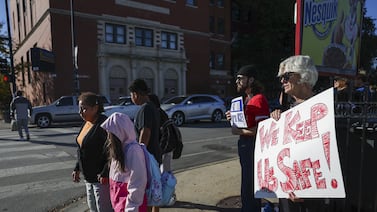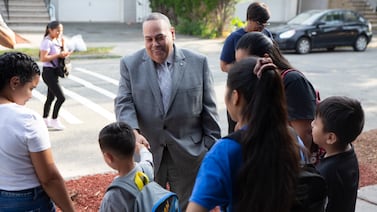Sign up for Chalkbeat’s free weekly newsletter to keep up with how education is changing across the U.S.
The child tax credit’s expansion during the pandemic cut child poverty nearly in half — but that more-generous credit expired in 2021. Research indicates poverty hurts children academically and in other ways. And many families worry about the cost of living.
All of that has spurred the campaigns of Vice President Kamala Harris and former President Donald Trump to talk about once again making the child tax credit more generous.
The two candidates differ on who should benefit and how much money families should get; Trump’s campaign in particular has been short on details. But an expanded child tax credit has the potential to cut down on the housing instability and food insecurity that disrupts kids’ lives and hurts their schooling.
“People get very frustrated about education achievement in our country, and teachers get very frustrated that the solution is always for them to do more,” said Elizabeth Ananat, an economics professor at Barnard College who’s studied how an expanded child tax credit could help kids.
When families don’t get the help they need, schools are expected to step in as the “sole providers of basically every social program.”
That’s why “advocates, for a long time, have been thinking that one way to address the income education gap,” Ananat added, “is by giving more supports to low-income families.”
But Republicans have sunk similar proposals to expand the child tax credit in Congress. How much children benefit from this kind of assistance depends a lot on how the policy is designed. And some teachers in high-poverty schools say the more generous pandemic-era child tax credit barely scratched the surface of families’ needs.
“Even with the tax credit, they were impoverished,” said Phylicia Butler, who taught music at an Arkansas elementary school in 2021 when Congress temporarily raised the child tax credit and gave it to more families.
Parents in North Little Rock used the payments for food and rent, she said. But kids were still coming to school wearing the same shirt three days in a row, or with their feet poking out of their shoes.
The history of the child tax credit
The child tax credit has long had bipartisan support and is popular among voters.
Just before the pandemic, families could get a tax credit of up to $2,000 per child, but the policy excluded many of the nation’s poorest families who pay little or nothing in taxes. Then, in 2021, Congress significantly expanded the child tax credit through the American Rescue Plan.
That law gave families up to $3,600 for kids under 6 and $3,000 for other children under 18. Crucially, it was “fully refundable,” which meant families could get that money even if they didn’t have any income or didn’t make much. And half of the money could be paid in monthly installments, which especially helped families living paycheck to paycheck.
That temporary policy helped lift some 2.9 million children out of poverty and cut the child poverty rate nearly in half — the biggest single-year drop in at least 50 years. Poverty rates fell most sharply for Black and Hispanic children.
Nick Bates, who directs the Hunger Network in Ohio, a faith-based nonprofit that advocates for anti-poverty programs, remembers how the extra cash helped his family of four cover the rising cost of food. Other parents used it to pay for things benefiting their children’s physical health and social connections after the pandemic’s disruption, like the swim team or the local YMCA.
“People were like: ‘Oh, thank God we got that this month, because I didn’t know how we were going to afford groceries next week, or be able to pay off the credit card,’” Bates said. “This kept a lot of families from spiraling out.”
When the pandemic policy expired, the credit reverted back to $2,000 per child and again excluded the lowest-income families. If Congress takes no action, the credit will drop down to $1,000 per child at the end of next year.
The child tax credit: What Harris and Trump say
The impending expiration of the current child tax credit, plus the ongoing financial hardship many families are experiencing, has created an incentive for politicians to highlight the policy.
“People like the child tax credit,” said Ashley Burnside, a senior policy analyst at The Center for Law and Social Policy, a nonprofit that supports expanding the child tax credit. Through surveys, her organization has seen this kind of policy can “reach voters and show them that the government cares about them as they raise their kids.”
Vice President Kamala Harris has said she wants to reinstate the pandemic-era policy and raise the credit to $6,000 for families with children less than a year old. Her running mate, Minnesota Gov. Tim Walz, helped to enact a child tax credit in his state after the federal pandemic-era policy expired. It’s the largest in the nation for lower-income households.
Trump hasn’t released a detailed policy, but his campaign said he would consider raising the credit to $5,000 per child for families of all income levels after his running mate, Ohio Sen. J.D. Vance, proposed the idea. But the Republican Party platform, which Trump backed, calls for a $2,000 per child credit that excludes many low-income families.
Republicans in Congress have blocked efforts to expand the child tax credit, including a bill last month that would have helped some 16 million children from low-income families. Vance missed that vote.
Still, experts say competing proposals to increase the size of the child tax credit will have little effect on child poverty if the nation’s poorest families can’t benefit from it. That means how the credit is structured can matter more than how much the credit is worth.
Expanding who’s eligible — for example to parents who make less than $3,500 or who are undocumented — is “the meat of the benefit,” Ananat said.
The pandemic-era child tax credit helped kids
The pandemic provided ample evidence of how an expanded child tax credit benefits kids.
Families with children reported on multiple surveys that they used the money to pay for essentials like groceries, rent, utilities, and clothing. Food insecurity among families with kids dropped sharply. Many families also used the money to pay for child care — and likely were able to enroll in centers they couldn’t afford before.

The payments also helped low-income families stay in their homes and avoid moving due to unpaid rent or mortgage bills. Low-income families who got the credit were less likely to say they were living “doubled up” with other family or friends — a living arrangement that typically leads schools to designate children as homeless.
Hunger, housing instability, and an unexpected move can all negatively affect a child’s ability to learn and regularly attend class.
Nagali Campos, a case manager who supports students experiencing homelessness in New Mexico’s Santa Fe Public Schools, recalls that some families in her community donated their payments to mutual aid groups so they could help undocumented parents who’d lost their jobs, some of whom struggled to access the payments they were newly eligible for.
Black and Hispanic families were especially likely to say they used the credit to pay for extracurricular activities and tutoring for their kids.
Many Black and Hispanic families also said the credit helped them save for college or send their child to a different school.
An expanded child tax credit’s benefits for society
A permanent expansion of the child tax credit could also have lasting effects on kids’ lives.
Research recently released by Ananat and Irwin Garfinkel, a research scientist at Columbia University’s School of Social Work, comes to the conclusion that a permanent version of the 2021 pandemic-era child tax credit would likely shrink racial and socioeconomic gaps in educational attainment.
Historically, decreases in child poverty have narrowed gaps between how kids of color and white students perform academically at school.
A paper released last month by researchers at the University at Albany, SUNY, for example, found that household income explains more than half of the gap in reading scores for Black and white students, and just under half of the gap for Hispanic and white students. When Michael Petrilli, the president of the conservative Thomas B. Fordham Institute, which commissioned the study, laid out the findings, he described an expanded child tax credit as one possible solution.
The program would more than pay for itself, because those kids would likely go on to earn more at work, pay more in taxes, be healthier, and require fewer social services.
A permanent expansion would likely help more of the hardest-to-reach families, too. During the temporary boost, some families missed out because they don’t file tax returns each year and didn’t know to do so.
If the program stuck around, it would be easier to tap “trusted messengers” to do intensive outreach, said Nikhita Airi, a research associate at the Urban-Brookings Tax Policy Center who’s studied the child tax credit.
That would be especially helpful for immigrant parents who may worry that filling out tax paperwork could affect their immigration status, and for new parents, who may not know about the credit.
“It’s a pretty decent way to get cash out to families fast,” Airi said. “We did see in 2021 some of the flaws in that. There are gaps.”
Chalkbeat national editor Erica Meltzer contributed reporting.
Kalyn Belsha is a senior national education reporter based in Chicago. Contact her at kbelsha@chalkbeat.org.





